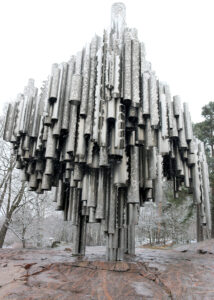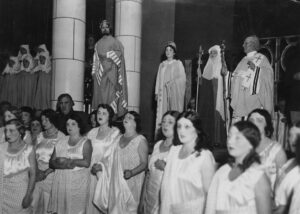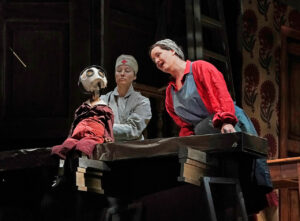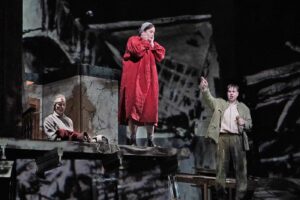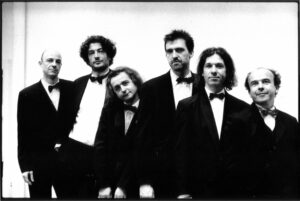Dziennik czasów zarazy
Drodzy moi – świat zdecydował za nas. Przez najbliższe tygodnie, a może i dłużej, nie pozostaje nam nic innego, jak zadbać o siebie i naszych bliskich, zachować spokój i wykorzystać ten czas z pożytkiem dla zaniedbywanych dotąd sfer życia. Nasłuchać się muzyki, naoglądać przedstawień i koncertów udostępnionych przez liczne instytucje w bezpłatnym chwilowo streamingu, a przede wszystkim naczytać. Właśnie ukazał się piąty numer „Ruchu Muzycznego”, a w nim rozmowa Izabeli Smelczyńskiej z Anią Karpowicz – flecistką, kuratorką i założycielką Hashtag Ensemble; rozważania, jak muzykować w sytuacji chronicznego niedofinansowania kultury w Polsce; a także fascynujący artykuł Elżbiety Szczepańskiej-Lange o Szymonie Pullmanie i jego „muzycznej szkatułce”, czyli sali Herman & Grossman przy Mazowieckiej w Warszawie, w kamienicy pod szesnastką. Oraz mój felieton, pisany dwa tygodnie temu, kiedy jeszcze wielu rzeczy nie wiedzieliśmy. A teraz już wiemy, więc uważajcie na siebie.
***
Mór zaczął się (…) na Wschodzie i spowodował tam wielkie spustoszenia. Powoli, z miejsca na miejsce się przenosząc, zaraza do krajów zachodnich dotarła. (…) Nie pomogło oczyszczanie miast przez ludzi do tego najętych, zakaz wprowadzania chorych do grodu, różne przestrzeżenia, co czynić należy, aby zdrowie zachować, ani też pokorne modlitwy, procesje i wszelkie pobożne dzieła”. Świadomie archaizowany opis kryzysu zdrowotnego, spowodowanego gwałtowną ekspansją koronawirusa w kilku krajach Europy? Nie, prolog do Dekameronu Boccaccia, w klasycznym przekładzie Edwarda Boyé. Zbiór opowieści florentyńczyków, którzy schronili się na wsi przed epidemią czarnej śmierci, nawiązuje kompozycyjnie do Księgi tysiąca i jednej nocy. I traktuje z grubsza o tym samym: jak odroczyć wyrok, snując niekończące się historie o miłosnych perypetiach i uciesznych przygodach ludzi najrozmaitszych stanów.
Czarna śmierć zawitała do północnych Włoch w styczniu 1348 roku. Pierwsze we Włoszech przypadki COVID-19, choroby wywołanej koronawirusem SARS-CoV-2, odnotowano w końcu stycznia 2020 roku w Rzymie. Nagły wzrost zachorowań na północy Italii nastąpił trzy tygodnie później. Byłam wtedy w Wielkiej Brytanii, dokąd wirus dotarł w tym samym czasie, kiedy pojawił się w Italii. Na ulicach miasta, w którym odbyła się z dawna oczekiwana premiera zapomnianej opery Verdiego, kłębiły się tłumy cudzoziemskich kibiców. Przyjechali na turniej niezbyt w Polsce popularnej dyscypliny sportowej – z kraju, gdzie SARS-CoV-2 rozgościł się jeszcze wcześniej i postawił odpowiedzialne służby w stan najwyższej gotowości.
John William Waterhouse: ilustracja do Dekameronu (1916).
W drodze powrotnej siedziałam w samolocie obok azjatyckiej wiolonczelistki, która przez całą drogę notowała w zeszycie wskazówki interpretacyjne do jakiegoś koncertu. Przez kontrolę graniczną w Warszawie przeszła bez kłopotu. Zwróciłam na nią uwagę tylko dlatego, że nieczęsto zdarza mi się podróżować w sąsiedztwie pochłoniętych pracą muzyków. Już w domu dowiedziałam się o upokorzeniu chińskiej pianistki Yuji Wang, przetrzymanej godzinę na lotnisku i powitanej w Vancouver przez słuchaczy w maskach przeciwwirusowych. Dwa dni później doszły mnie wieści o zamknięciu teatrów operowych w północnych Włoszech: mediolańskiej La Scali, Teatro Regio w Parmie, weneckiej La Fenice, oper w Weronie, Bolonii, Rawennie i Piacenzy. Pod koniec tygodnia zapadła decyzja o odwołaniu wszystkich wydarzeń z udziałem tysięcznej publiczności w sąsiedniej Szwajcarii.
Nie wpadam w panikę. Jeśli cokolwiek mnie niepokoi, to poziom niewiedzy medycznej moich rodaków. Środki zapobiegawcze przed koronawirusem niewiele się różnią od sposobów przeciwdziałania pospolitej grypie, która rok w rok dotyka miliony Polaków i zbiera śmiertelne żniwo wśród najmniej odpornych. Z drugiej strony o SARS-CoV-2 nie wiemy właściwie nic. Grypa hiszpanka, która przed stuleciem zmiotła z powierzchni ziemi ponad 50 milionów istnień ludzkich, pojawiła się wiosną 1918 roku. Z początku była bardzo zaraźliwa, ale łagodna w przebiegu – podobnie jak koronawirus wywołujący COVID-19. Druga fala nadeszła kilka miesięcy później i pociągnęła za sobą ogromną liczbę ofiar, przede wszystkim wskutek powikłań w postaci odoskrzelowego zapalenia płuc. Potem miał miejsce trzeci epizod, zabójczy dla osób w sile wieku, które dotąd przechorowywały „normalną” grypę bez szwanku.
Kiedy piszę te słowa [1 marca – przyp. mój], w Polsce nie odnotowano jeszcze ani jednego przypadku zakażenia koronawirusem. Oby tak zostało, choć dla osób związanych z branżą muzyczną i tak nie ma to większego znaczenia. Jesteśmy Europejczykami, obywatelami świata, wciąż siedzimy na walizkach. Cios może nadejść z każdej strony. Z dnia na dzień mogą posypać się plany koncertowe muzyków. Kolejne teatry i filharmonie mogą ogłosić bezterminową kwarantannę, biura prasowe – odmówić krytykom akredytacji, linie lotnicze – odwołać kursy do stref zagrożonych zarazą.
W Szwajcarii już brakuje w sklepach mąki i mydła. Notowania na giełdach światowych lecą na łeb na szyję. Tajemniczy koronawirus spadł na nas jak Czarny Łabędź i odciska piętno na naszym życiu. Może warto wziąć przykład z florentyńczyków, którzy „zgromadzali się w domach swoich, gdzie żyli odcięci od świata całego. Jadali letkie potrawy, pili powściągliwie wyborne wina i chuciom cielesnym nie folgując, czas swój na muzyce i innych dostępnych im przyjemnościach trawili”. Nie najgorszy to pomysł na zapomnienie o zarazie i śmierci, o których ani słyszeć nie chcemy.



